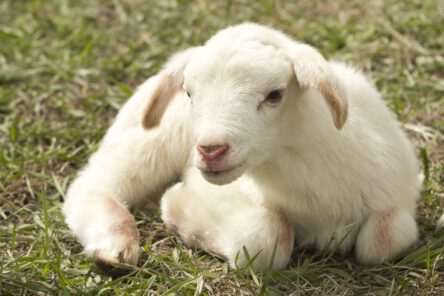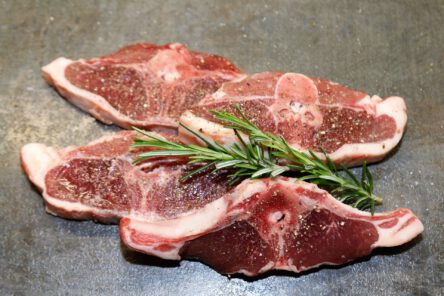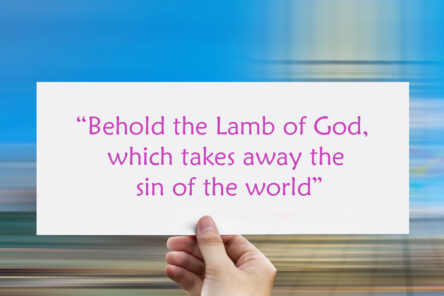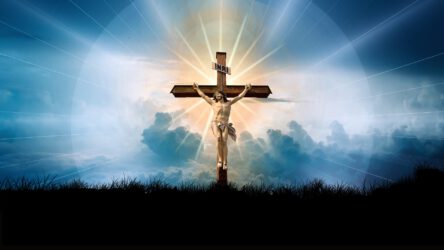
A lamb is a young animal in a sheep or goat. My fondest childhood memories include two newborn fawn. My mother brought her to the nursery early in the morning. Very carefully, we children took them in our arms and stroked these fawn. One of the two became my favorite animal, it was adorned with two little shags at the throat. We had a lot of fun when they drank from the mother goat’s udder and then made their high-spirited jumps.
Lambs as sacrificial animals
Lambs were offered as sacrificial animals very early on. In Genesis 4:4 we read that Abel slaughtered one of the first lambs of his flock and offered the best cuts of meat as a sacrifice to the Lord.

In the law, the sacrifice of male year-old sheep was part of the Passover instituted before the Exodus from Egypt:
The blood shall be a sign for you, on the houses where you are. And when I see the blood, I will pass over you, and no plague will befall you to destroy you, when I strike the land of Egypt.
Exodus 12,13 (ESV)
The annual slaughter of the Passover lamb on the Passover festival thus became an unforgettable reminder of redemption from Egyptian slavery and at the same time a prospect of redemption through the sacrificial lamb, Jesus Christ.
A reference to Isaiah’s prophecy:
He was oppressed, and he was afflicted, yet he opened not his mouth; like a lamb that is led to the slaughter, and like a sheep that before its shearers is silent, so he opened not his mouth.
Isaiah 53,7 (ESV)
The lamb is an image of innocence, of infallibility, silent before its shearer. A fine type of Christ the Lamb of God.
Christ the Lamb of God is announced
At the age of 30, Jesus was introduced to his earthly mission by John the Baptist: “Behold the Lamb of God, which takes away the sin of the world” John 1:29. John makes it clear that this Jesus walking by is the sacrificial Lamb of God.

Jesus performed great miracles, healing the sick, freeing the demoniac and helping the oppressed. After only three years of service, he becomes the Passover lamb himself.
Christ the Lamb dies
John emphasizes one thing in particular: „…which bears the sin of the world.“ The Greek word for bearing has a double name: it means to stand under it, or to carry away. Jesus did both.
After the scourging and condemnation, Jesus took the cross and carried it up to Calvary. There he took upon himself the sins of the whole world and thereby carried them away from our lives.
He himself bore our sins in his body on the tree, that we might die to sin and live to righteousness. By his wounds you have been healed. 1. Peter 2,24 (ESV)

When the Baptist says that Jesus bears the sins of the whole world, he is indicating the scope of the redemptive power of his blood.
It’s enough for all generations around the world! But whoever does not accept Jesus as the Redeemer will be eternally lost despite the death on the cross.
For the word of the cross is folly to those who are perishing, but to us who are being saved it is the power of God. 1. Corinthians 1,18 (ESV)
The offer
There is no other sacrifice here on earth that would suffice to take away our sins. No animal could be a perfect sacrifice for man.
It took a flawless man to be sacrificed in expiation for man’s sins. Jesus is this spotless sacrificial lamb. He died for our sins on the cross.
Have you already accepted this offer?
Author: Egon Waechter
Pictures: https://pixabay.com/de/

Ein Lamm ist ein junges Tier bei Schaf oder Ziege. Zu meinen schönsten Kindheitserinnerungen, gehören zwei neugeborene Ziegleien. Meine Mutter brachte sie am frühen Morgen ins Kinderzimmer. Ganz vorsichtig nahmen wir Kinder sie auf die Arme und streichelten diese Ziegleien. Eins der Beiden wurde mein Lieblingstier, es war an der Kehle geschmückt mit zwei Zottelchen. Großen Spaß hatten wir, wenn sie am Euter der Mutterziege tranken und anschließend ihre übermütigen Sprünge machten.
Lämmer als Opfertiere
Lämmer wurden schon sehr früh als Opfertiere dargebracht. In 1. Mose 4,4 lesen wir, daß Abel eins von den ersten Lämmern seiner Herde schlachtete und die besten Fleischstücke dem Herrn als Opfer darbrachte.

Im Gesetz gehörte das Opfer männlicher einjähriger Schafe zum Passah, das vor dem Auszug aus Ägypten eingesetzt wurde:
„Eure Türen aber sollen durch das Blut bezeichnet sein. Überall, wo ich dieses Blut sehe, werde ich vorübergehen, und so werdet ihr verschont bleiben, wenn ich strafend durch ganz Ägypten gehe“. 2.Mose 12,13. (GNB)
Die alljährliche Schlachtung des Passahlammes am Passahfest wurde so zur unvergeßlichen Erinnerung an die Erlösung aus der Knechtschaft Ägyptens und zugleich zum Ausblick auf die Erlösung durch das Opferlamm Jesus Christus.
Ein Hinweis auf Jesajas Prophezeiung:
Er wurde misshandelt, aber er duldete es ohne ein Wort. Er war stumm wie ein Lamm, das man zur Schlachtung führt. Und wie ein Schaf, das sich nicht wehrt, wenn es geschoren wird, hat er alles widerspruchslos ertragen. Man hörte von ihm keine Klage. Jesaja 53,7 (HFA)
Das Lamm ist ein Bild der Unschuld, der Unfehlbarkeit, das verstummt vor seinem Scherer. Ein treffliches Vorbild auf Christus das Lamm Gottes.
Christus das Lamm Gottes wird angekündigt
Jesus wird mit 30 Jahren von Johannes dem Täufer in seine irdische Mission eingeführt: „Siehe das ist Gottes Lamm, welches der Welt Sünde trägt“ Johannes 1,29. Johannes macht deutlich, dass dieser Jesus, der dort vorübergeht, das Opferlamm Gottes ist.
Jesus tat große Wunder, er heilte Kranke, befreite Besessene und half den Unterdrückten. Nach nur drei Jahren Dienstzeit wird er das Passahlamm selbst.
Christus das Lamm stirbt
Johannes hebt eins besonders hervor: „… welches der Welt Sünde trägt.“ Das griechische Wort für tragen hat einen Doppelnamen: Es bedeutet sich darunter stellen, oder wegtragen. Beides hat Jesus getan.
Nach der Geißelung und Verurteilung nahm Jesus das Kreuz und trug es hinauf nach Golgatha. Dort nahm er die Sünden der ganzen Welt auf sich und hat sie damit aus unserem Leben hinweggetragen.
Der unsre Sünden selbst hinaufgetragen hat an seinem Leibe auf das Holz, damit wir, den Sünden abgestorben, der Gerechtigkeit leben. Durch seine Wunden seid ihr heil geworden.
1.Petrus 2,24 (LUT)

Wenn der Täufer sagt, Jesus trage die Sünden der ganzen Welt, dann bezeichnet er die Reichweite der Erlösungskraft seines Blutes.
Es reicht für alle Generationen auf der ganzen Welt! Wer aber Jesus als den Erlöser nicht annimmt, der geht trotz des Kreuzestodes ewig verloren.
Denn das Wort vom Kreuz ist eine Torheit denen, die verloren werden; uns aber, die wir selig werden, ist es Gottes Kraft. 1.Korinther 1,18 (LUT)
Das Angebot
Hier auf Erden gibt es kein anderes Opfer, das ausreichen würde, um unsere Sünden hinweg zunehmen. Kein Tier konnte ein vollgültiges Opfer für den Menschen sein.
Es bedurfte eines fehlerlosen Menschen, um als Sühne für die Sünden des Menschen geopfert zu werden. Jesus ist dieses fehlerlose Opferlamm. Er starb für unsere Sünden am Kreuz.
Hast Du dieses Angebot bereits angenommen?
Autor: Egon Waechter
Bilder: https://pixabay.com/de/